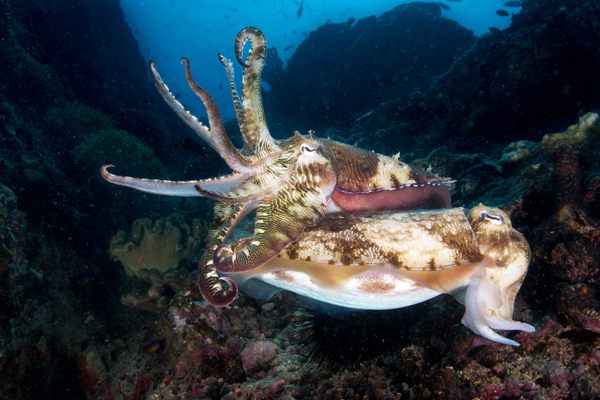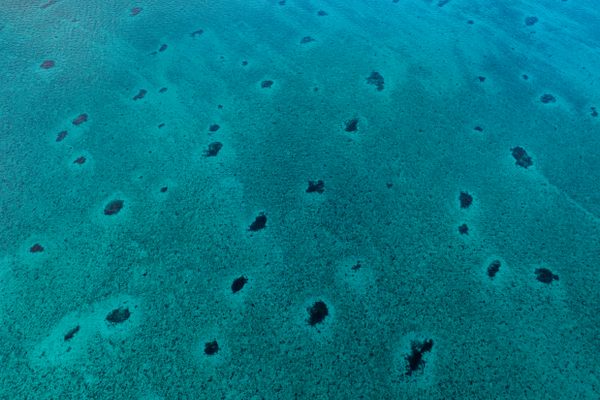From Turtles to Whales, Marine Animals Have the Same Moves
With the help of remote tracking devices, scientists are deducing the choreography of the sea.

If the ocean were a dancefloor, it would be full of improbable pairs. Black-footed albatrosses top out around 6 pounds, while short-finned pilot whales weigh about 6,600. It would take 20 little penguins on top of each other to reach the height of a hammerhead shark standing on its tail, and a polar bear would probably rather eat a California sea lion than waltz with it.
According to a new study, though, these animal duos each have some moves in common. In a new paper published in the Proceedings of the National Academy of Sciences, an international team of researchers used tracking device data to better understand the motion in the ocean, comparing the daily movement patterns of thousands of animals across 50 different species. They found that even though some sea creatures are much bigger than others, many of them share the same basic choreography, something that is much less true for animals on land.

Whether animals fly, scuttle, or swim, their movements are powered by internal factors, like body size and metabolism, and constrained by external ones, like temperature, or how tightly packed the trees are in a forest. The details of how they move—how fast they go, say, or the angles at which they turn—are determined by how these factors intersect. As this new paper points out, scientists have wanted to figure out the rules determining this balance since at least 350 B.C., when Aristotle wrote of the need for “an investigation into the common ground of any sort of animal movement whatsoever.”
Contemporary researchers have a new tool at their disposal: remote tracking devices, which, when attached to animals, let far-off scientists keep tabs on their movements. Over the past few decades, researchers have used trackers to study everything from where ducks go in winter to how baboons make decisions. This particular study piggybacked on data collected from previous studies about elephant seal foraging, shark population decline, and how often leatherback sea turtles snack on jellyfish, to name just a few. “We realized that if we all share our data and work together in a concerted manner, we can learn a lot more about these animals,” coauthor Daniel Costa told Eurekalert.

The researchers used tracking data from 2,600 animals belonging to 50 different species, which collectively checked in from 2.8 million locations around the world. Some of the information dates back to 1985, while other sets were collected as recently as 2015. With all this information at hand, the researchers were able to “ask questions that transcend patterns of individual species,” one of the study’s co-authors, Prof. Michael Berumen, told Eurekalert. Albatross and shark speeds could be compared with one another. Whale wendings and turtle turns were studied side by side.
The results surprised the researchers. On land, previous studies have found that intrinsic physical stats, like body size and metabolism, determine how animals move. In the oceans, though, external factors proved more important. For the species studied, “movement patterns show a remarkable convergence, being strongly conserved across species and independent of body length and mass,” even though some of the animals being studied were as much as 10 billion times larger than others, the paper says. (The main exception was the group of true seals—including crabeater seals, elephant seals, and Weddell seals—whose length affected their speed.)

Other factors—including different species’ breeding and foraging strategies, or even whether they paddled, swam, or flew—also didn’t seem to make much of a difference in movement patterns. Instead, the second-biggest influence was where the animals were hanging out. (The biggest was species identification; Macaroni penguins move like Macaroni penguins, after all.) Animals that spend most of their time along the coast—from beluga whales to green turtles—tend to move in more complex ways, turning more often and retracing their steps.
In the open ocean, things are simpler: animals who prefer it there, like black-footed albatrosses and whale sharks, will pick a spot in the distance and shoot for it. “It makes sense, because the coast is … much more complicated,” said Costa. “Regardless of what species it is, the movement patterns match the oceanographic features of the environment.” The water itself also likely plays a part: its buoyancy and three-dimensionality help to make an even playing field for animals of all different sizes and shapes.

This playing field is changing fast, though: Arctic ice is melting, coasts are rearranging, and sea levels are rising as oxygen levels dwindle. As these shifts accumulate and accelerate, researchers hope that understanding animals’ movements will help us predict what they might do in turn. If shoreline-hugging animals are used to navigating more complexly, they might be able to adapt en masse to their habitats’ shifting shapes. Meanwhile, those who instead go full speed ahead in the open ocean might be less flexible.
Now that these patterns are being pinned down, researchers can also loop in the many creatures that weren’t included in this survey. “Many of these species are endangered and we have no tracking data,” said Costa, “but we can extrapolate from other species to understand how they are likely to interact with fisheries, shipping, or other human activities.” If we want to smoothly insert ourselves into this oceanic choreography, it helps to know the dance steps.






















Follow us on Twitter to get the latest on the world's hidden wonders.
Like us on Facebook to get the latest on the world's hidden wonders.
Follow us on Twitter Like us on Facebook